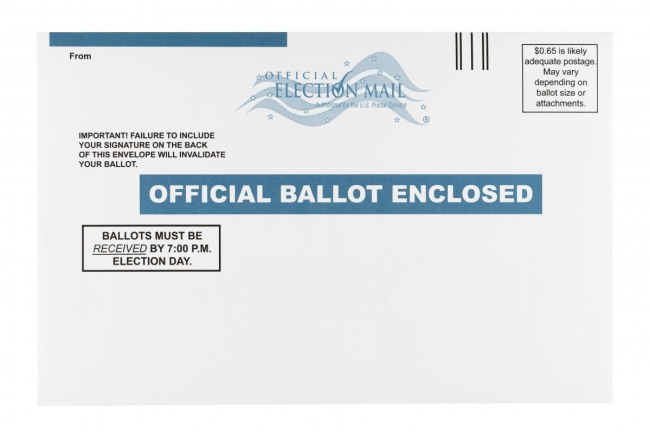You have /5 articles left.
Sign up for a free account or log in.

SKrow/ISTOCK.COM via Getty Images
College students vote at lower rates than the overall population, but the number of student voters has been on the rise in recent years. Their numbers nearly doubled from the 2014 to 2018 midterm elections, jumping from 19 to 40 percent, according to a report by the Institute for Democracy and Higher Education at Tufts University.
The institute released a new memorandum today advising college administrators on how to prevent a reversal of that trend and encourage student voting during the pandemic -- and after.
Nancy L. Thomas, the institute’s director and a co-author of the memorandum, said she is “extremely” worried about student turnout in the upcoming presidential election.
“In January, I was giving talks to college and university presidents telling them not to worry about 2020, that they only need to worry about 2022,” she said. “Then COVID hit and I realized immediately that election laws and rules were all going to be a muddle-y mess and there would be lots of efforts to disenfranchise certain groups, including college students.”
Observers have raised concerns in recent years about voter ID and residency requirements that make it more difficult for students to vote. In April, a New Hampshire state judge dismissed a Republican-backed state law passed in 2017 that made it more complicated for students to establish residency to vote.
Republican lawmakers have justified more restrictive voter ID and registration laws as being intended to inhibit voter fraud, but many observers see a partisan motivation at play, as young voters disproportionately identify as Democrats.
A new survey of 4,000 college students from the Knight Foundation released Monday found that 70 percent plan to vote for Democratic candidate Joe Biden for president, while just 18 percent prefer President Trump. About seven out of 10 students said they are “absolutely certain” they will vote in the presidential election, but nearly half (49 percent) expressed a lack of confidence in the legitimacy of the election. Just over half of students plan to vote by mail or absentee, with students who identify as Democrats being twice as likely as Republicans to prefer a mail-in option (63 percent versus 31 percent).
The new memorandum makes a number of specific recommendations for encouraging student voting, and notes challenges around student voting that come with a heavier reliance on mail-in ballots.
“Students living on or near campus who register there tend to vote at higher rates, but residential students who vote absentee or by mail do not follow through as regularly,” reads the memorandum, which was jointly released by the Tufts institute, the Andrew Goodman Foundation and the Fair Election Center's Campus Vote Project. “There is also evidence that students vote provisionally more than other voters, that those provisional ballots are not only over-relied on but also disproportionately rejected compared to other voters, and that students’ absentee or mailed-in ballots are similarly rejected at disproportionately higher rates. Absent interventions, the removal of barriers to voting by mail, and education, voting rates for students will be low in 2020.”
The memorandum suggests colleges should advocate for online voter registration and “robust” mail-in voting, in addition to supporting “excuse-free” early voting with extended hours and working with state election officials to locate polling places or ballot drop boxes on campuses.
Other recommendations center on identification requirements. The memorandum suggests that colleges should advocate for the acceptance of student IDs for voting, or, in lieu of that, for students to be able to use any government-issued ID, including one issued by another state, as proof of identity.
The memorandum also offers ways to make it easier for students to establish local residency to vote near their campus, such as by requiring states to accept enrollment lists with student names and addresses provided by colleges.
"Such an approach has been a proven best practice in some jurisdictions, and removes the onus from the student, allowing, for example, registrars to work with election administrators to communicate this information," the memorandum states.
The memorandum says colleges should advise students who have a choice between voting from their prior address or their campus address to register to vote “where they will be the most motivated to vote and where voting will be the most convenient.”
“Our recommendation that students should consider convenience stems from research on barriers to voting,” the memorandum states. “It suggests that students should consider a range of factors, such as the availability of early voting, requirements for voting by mail, ability to travel to polling locations, and the relative convenience of voting physically nearby. Having students study and think through their options is consistent with higher education’s educational mission.”
A final recommendation focuses on voter education.
"As the election rapidly approaches, and voting conditions continue to change, education will be crucial to maintaining the increases in student turnout we have seen in the past few elections," the memorandum says. "Colleges and universities can help by ensuring that their students know about ID requirements, registration deadlines, and other information and how, when, and where they can submit their ballots."
“There are things that both administrators on campus and local and state election officials can do to make this easier for college students to navigate,” said Jennifer Domagal-Goldman, the executive director of the ALL IN Campus Democracy Challenge at Civic Nation, a nonprofit organization. “My particular worry is campuses that open and may have resurgences in COVID that force them to close in mid- to late October. If students who may have wanted to vote in person at local campus precincts are sent home, will they be able to at that point vote absentee or reregister” at their parents' address, she asked. She noted that the ability to do those things varies greatly across states.
Several bills proposed by Democrats in Congress aim to protect student voting rights this election.
The Protect the Youth Vote Act, introduced this month, seeks to combat age discrimination in voting, including laws that would restrict the right of college students to vote near their campuses, and ID or other documentation requirements that have "the purpose or effect of denying or abridging the right to vote on account of age."
Another bill, the National Emergency Student Vote Act, would require colleges to share resources with students on registering to vote, requesting absentee ballots and options for casting their vote even if they are not on campus this fall.
“COVID has thrown this fall semester into question and with it the traditional get-out-the-vote organizing that happens on campuses, both high school and college campuses,” said Jesse Barba, the senior director of external affairs for Young Invincibles, a nonprofit that is advocating for the bill. “There's a fundamental question: If the pandemic remains dangerous enough in November to alter how students vote, who will provide up-to-date information to college students? We believe, full stop, that the institutions enrolling them is the answer.”








